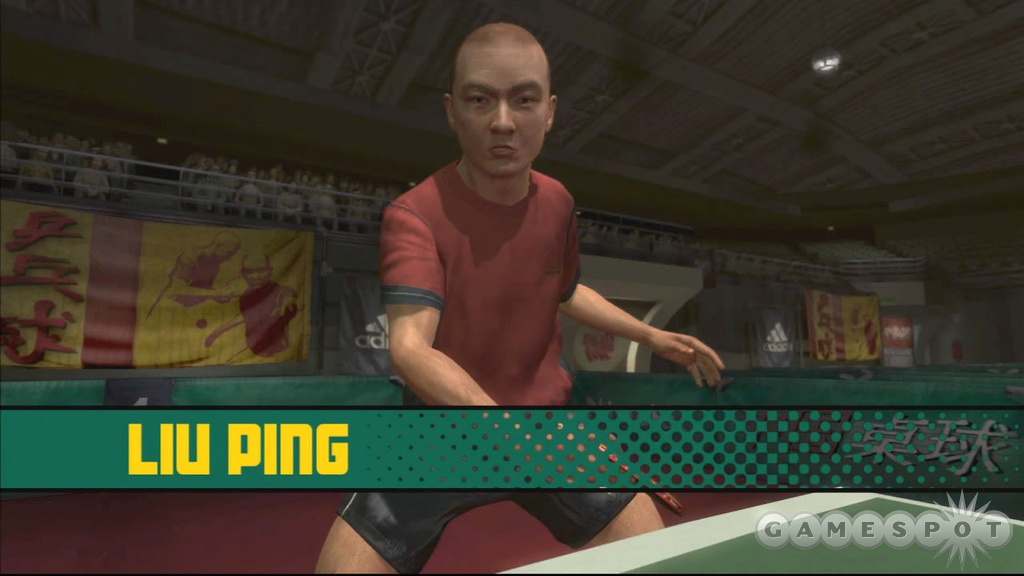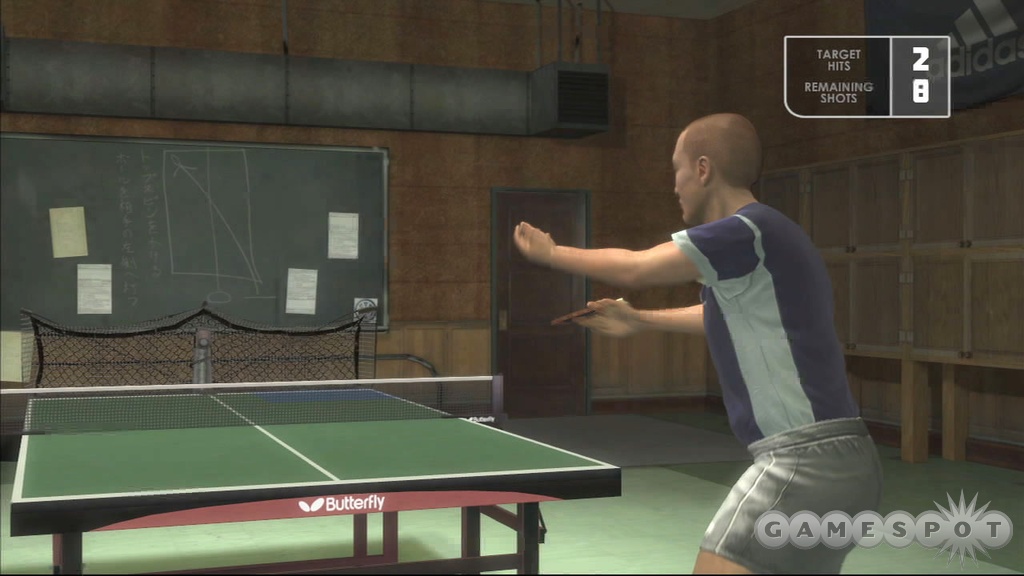As one of the first commercially available video games, Pong seems to have an almost academic importance, but not enough credit is given to the simple elegance of its design--two bar-shaped "paddles," one square "ball"--something that was born largely out of technical limitations. There is an obvious correlation between Pong and the newly minted Rockstar's Table Tennis for the Xbox 360, in that Table Tennis is literally a ping-pong simulation. But it also follows the same philosophy of stripping the experience down to its essence, something focused and intense. Rockstar's Table Tennis treats the game like a serious sport, taking incredible care to present some of the most realistic player characters ever put in a game and delivering frenetic and nuanced action.

In the real world, it's easy to write off table tennis as a stunted summer-camp version of real tennis, even though table tennis is an Olympic sport. This isn't to say that there's not skill and technique involved in table tennis, but the barrier to entry and the physical exertion are much lower. As a video game, though, Table Tennis plays like a high-speed distillation of the gameplay offered by the likes of Virtua Tennis and Top Spin, and like the most addictive of games, the action is easy to pick up but still rich with the kind of subtlety that makes it a challenge to truly master. You have four different types of shots--topspin, backspin, left spin, and right spin--which correspond to the four face buttons on the controller. Alternately, you can use the right analog stick to trigger the different shot types, though this method is a lot more difficult to come to grips with. The longer you hold one of the shot buttons during the ball's approach, the more power you'll put behind your swing, and you can also lean the left analog stick during this charge-up period to influence the direction of your shot, though your table position and the incoming trajectory of the ball figure heavily into where your shot will end up, as well.
This will all seem like really familiar ground for anyone who's played any sort of modern tennis video game, but Table Tennis separates itself in several crafty ways, turning the gameplay into something unique. It all starts with the serve meter, which combines both a rising spin meter and an oscillating power meter, giving you more flexibility with how your serve gets delivered. You can choose to go full-bore with maximum spin and maximum shot power and hope to overpower your opponent, you can fake out your opponent with a weak, spin-heavy shot that will bounce twice before they even know what happened, and so on. Once the ball is in play, the game puts a faint color-coded halo around the ball that clues you in on which type of spin your opponent used, and you can take that momentum and throw it right back at them by countering with the same shot type. Color-blind players should take note that, while this is a really nice piece of visual shorthand for most people, they might find it difficult to differentiate between the colors.
As you get into the more-advanced techniques, your four standard spin shots can also be combined to create hybrid spin shots by holding multiple buttons at once, giving you access to shots that blend the speed of a topspin and the curve of a sidespin shot. You also have a focus meter that fills as you successfully return the ball, which you can tap into by holding the right bumper before you start charging up your swing, unleashing an even faster, more potent shot that can easily catch your opponent off guard. There are other small touches at work here, as well, which really help capture the specifics of table tennis, such as the way a ball will bounce off in an unpredictable direction when it hits an edge or how a player can, on rare occasion, recover a shot after it bounces off his or her body. One of the most subtle features, and arguably one of the best little details in Table Tennis, is the use of force feedback. As you charge up your return shot and use the left analog stick to aim it, the controller will start to rumble as your aim gets closer to the edge of the table, giving you a tactile sense for when you need to stop pushing toward the edge. It makes the aiming simultaneously more intuitive and more effective, and it's so simple and so brilliant that it will be disappointing if the next crop of regular tennis video games doesn't implement a similar feature.

Table Tennis is definitely more concerned with getting the core gameplay correct than it is with adding frills, which comes through in the game's relatively modest options. The offline game consists of four different tournaments, each one bigger and more challenging than the previous. You might be able to breeze through the first tournament with just the topspin shot, but the difficulty of the AI ramps up to a nice, tense challenge in the second tournament, and by number three you're going to be sweating each and every swing of the paddle. There seems to be some unique AI at work as well, with each opponent having his or her own strengths and weaknesses, and part of the challenge lies in finding the different techniques that your opponents are susceptible to. There's also one-off exhibition mode that pits you against either a CPU opponent or a second player. Unfortunately, all match types are limited to one-on-one table tennis, so there's no doubles play. The single-screen two-player matches work better here than they do in most tennis games, largely because there isn't as much ground to cover, making the backcourt perspective less of a handicap. The game encourages you to keep coming back to the single-player game with the promise of unlockable characters, costumes, and arenas.
For that matter, the game has a really well-balanced set of unlockable achievements to keep you going, which go from simplistic stuff like going through the game's basic tutorial, to genuine challenges like playing through an entire tournament in 14 minutes or less, to stuff like racking up 10-plus hours of gameplay time. Several of the achievements can also be had through different routes, though the game is purposely oblique about what, exactly, those alternate routes are. There's Xbox Live support, as well, with ranked matches, instant tournaments for up to eight players, and the ability to tweak a few match variables such as the number of rounds and the score needed to win. As much as it would have been nice to see a Virtua Tennis-style career mode, complete with a character creation system and crazy minigames, the gameplay in Table Tennis just feels so right that a short list of modes is easy to accept. A lower-than-average retail price helps.
The focused design of Table Tennis works to its advantage in other ways, though, specifically with regards to the presentation. There are 11 different prefab players for you to choose from, and you'd have a hard time finding player models in any other game that look and move more convincingly. Eyes gleam with life; shirts shift around as the players move; sweat beads up and glistens on the skin as the match progresses, eventually seeping through the fabric of the player's shirt. The animations themselves have a really natural, fluid look to them, as well, with different players holding their paddles in different ways and occasionally displaying unique little physical tics, though some of the transitions feel a little mechanical. They also manage to bypass the "uncanny valley"--that uncomfortable level of realism that's both too realistic, and not realistic enough--most of the time, though occasionally you'll catch an odd angle on a player during a replay that just looks…off.

For all the phenomenal detail that is poured into the players, there's not much else to look at. The different arenas you can play in definitely have their own unique atmosphere, ranging from a run-down rec center to the Chinese National Table Tennis Arena, but when you're actually playing, all you'll see is two players, a table, and a ball. The frame rate is usually rock-solid, though when it does dip it's quite noticeable, and it occurs seemingly for no good reason. Some games might put a premium on lots of background noise, but it seems like this minimalist presentation is beneficial to the pacing and intensity of the gameplay. Besides, the game's surprisingly crisp sound design provides plenty of its own distractions in the form of some distinct crowd noise. You'll hear specific encouragement from fans, nationalist chants, and the rumbling stomp of feet in the grandstands. There are also techno tracks that kick in when you get locked into a really serious rally. But the music can get pretty cheesy, so not everyone will enjoy it, because it doesn't quite fit with the game's otherwise-straight-laced tone.
Thanks in no small part to Rockstar's own Grand Theft Auto series, there is a trend in game design right now to constantly expand the scope of your game, a real "bigger is better" mentality. The idea of an open-ended game is fun, but there's also something to be said for focusing on a single task and executing it with incredible detail and precision, which is exactly what Table Tennis does. This is one of the most accessible and exciting pure action games to hit the Xbox 360 so far, and one that can be easily recommended to just about anyone.